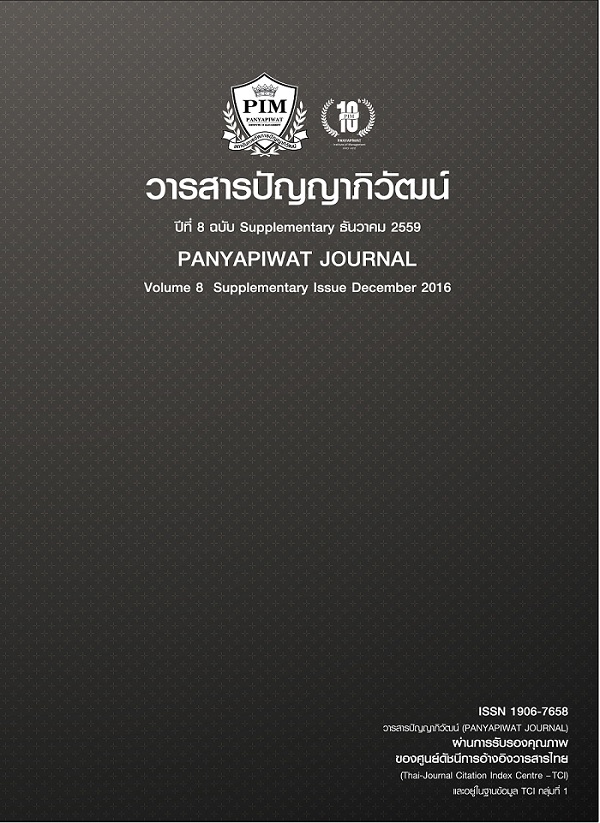THE ANALYSIS OF GENDER DIFFERENCES ON INFLUENTIAL FACTORS FOR DOG FOOD PURCHASING
Main Article Content
Abstract
With the rising trend of humanizing pets, especially dogs, and vast market potential for premium dog food, this research explores the demographic characteristics of wet dog food consumers and looks at influential factors that have the impact on dog owners’ purchasing decisions. There are two main categories of influential factors that this research looks at. The first group is related to experts that have knowledge or experiences with dog food. This group is comprised of breeders, veterinarians, specialty store staff, online dog forums, and family and friends. The second group is comprised of four marketing mixes – product, price, place, and promotion. For the purpose of segmentation, this research then further explores whether males and females are different in their spending of wet dog food, and whether they are influenced differently by breeders, veterinarians, specialty store staff, online dog forums, family and friends, and the four marketing mixes.
สืบเนื่องจากแนวโน้มการเลี้ยงสุนัขที่เพิ่มขึ้น รวมทั้งตลาดอาหารสุนัขระดับพรีเมี่ยมที่มีการขยายตัวอย่างรวดเร็ว งานวิจัยชิ้นนี้มีวัตถุประสงค์เพื่อศึกษาข้อมูลพื้นฐานกลุ่มลูกค้าที่ซื้ออาหารสุนัขแบบเปียก รวมทั้งศึกษาถึงปัจจัยที่มีอิทธิพลต่อการตัดสินใจซื้ออาหารสุนัข โดยได้ศึกษาปัจจัยที่มีอิทธิพลในสองกลุ่ม ได้แก่ กลุ่มผู้เชี่ยวชาญด้านโภชนาการและสุขภาพของสัตว์เลี้ยง อันประกอบด้วยฟาร์มสุนัข สัตวแพทย์ พนักงานประจำร้านเฉพาะทางเกี่ยวกับสุนัข ออนไลน์ฟอรั่มเกี่ยวกับสุนัข และครอบครัวและเพื่อน กลุ่มที่สองประกอบด้วยปัจจัยด้านส่วนผสมทางการตลาด ได้แก่ ผลิตภัณฑ์ ราคา สถานที่ และโปรโมชั่น นอกจากนี้งานวิจัยชิ้นนี้ยังได้ทำการวิเคราะห์ต่อไปว่าปัจจัยที่มีอิทธิพลต่อการตัดสินใจซื้ออาหารสุนัข อันได้แก่ ฟาร์มสุนัข สัตวแพทย์ พนักงานประจำร้านเฉพาะทางเกี่ยวกับสุนัข ออนไลน์ฟอรั่มเกี่ยวกับสุนัข และครอบครัวและเพื่อน ปัจจัยด้านส่วนผสมทางการตลาดทั้งสี่ มีความแตกต่างระหว่างกลุ่มผู้ซื้อเพศหญิงและชายหรือไม่
Article Details
I and co-author(s) certify that articles of this proposal had not yet been published and is not in the process of publication in journals or other published sources. I and co-author accept the rules of the manuscript consideration. Both agree that the editors have the right to consider and make recommendations to the appropriate source. With this rights offering articles that have been published to Panyapiwat Institute of Management. If there is a claim of copyright infringement on the part of the text or graphics that appear in the article. I and co-author(s) agree on sole responsibility.
References
Anuwong, W. (2012). Pet foods: growth opportunities amidst crises and beyond. In Pet Foods Forum Asia. London: Euromonitor International.
Bakewell, C. & Mitchell, V. (2006). Male versus female consumer decision making styles. Journal of Business Research, 59(12), 1297-1300.
Cheong, H. J. & Morrison, M. A. (2008). Consumers’ reliance on product information and recommendations found in UGC. Journal of Interactive Advertising, 8(2), 38-49.
Chen, I. C. & Hu, S. C. (2012). Gender differences in shoppers’ behavioural reactions to ultra-low price tags at online merchants. Springer Science Business Media New York, 12(4), 496-501.
Dawes, J. G. (2013). Price-related promotions are mostly bought by existing brand buyers. Retrieved January 10, 2014, from http://papers.ssrn.com/sol3/papers.cfm?abstract_id=2199169
Dibb, S. (2005). Market segmentation implementation barriers and how to overcome them. The Marketing Review, 5(1), 13-30.
Euromonitor International. (2011). Dog Food in Thailand. Retrieved January 10, 2014, from http://www.euromonitor.com/dog-food-in-thailand/report
Euromonitor International. (2011). Dog Food in the US. Retrieved January 10, 2014, from http://www.euromonitor.com/dog-food-in-the-us/report
Funk, D. & Ndubisi, N. O. (2006). Colour and product choice: A study of gender roles. Management Research News, 29(1/2), 41-52.
Gasiorowska, A. (2011). Gender as a moderator of temperamental causes of impulse buying tendency. Journal of Customer behaviour, 10(2), 119-142.
Kaplan, A. M. (2012). If you love something, let it go mobile: Mobile marketing and mobile social media 4x4. Business Horizons, 55(2), 129-139.
Kumcu, A. & Woolverton, A. E. (2010). Feeding Fido: Consumer Food Preferences Bring Pets to the Table. Journal of Food Products Marketing, 21(2), 213-230.
Lamb, C. W., Hair, J. F. & McDaniel, C. F. (2008). Marketing. London: Cengage.Lee, J. A. & Kacen, J. J. (2008). Cultural influences on consumer satisfaction with impulse and planned purchase decisions. Journal of Business Research, 61(3), 265-272.
Lemon, C. (2007). Brands, expectations and experience. In L. Fogli (Ed.). Customer service delivery: Research and best practices. (pp. 83-132). Hoboken, NJ: John Wiley and Sons.
Manteca, X., Villalba, J. J., Atwood, S. B., Dziba, L. & Provenza, F. D. (2008). Is dietary choice important to animal welfare?. Journal of Veterinary Behavior: Clinical Applications and Research, 3(5), 229-239.
Nesheim, M. C. & Nestle, M. (2010). Feed Your Pet Right. New York: Free Press.
Nilsson, C., Liashchenko, A. & Andreasson, R. (2010). Customers’ buying behavior toward premium dog food brands: A case study of Bozita Robur. Jönköping University, Jönköping International Business School.
Nunnally, J. (1978). Psychometric theory (2nd ed.). New York: McGraw-Hill.Pet University (n.d.). Types of Food. Retrieved December 10, 2011, from http://www.petuniversity.com/dogs/health--nutrition/types-of-food
Prasad, A. (2010). Demand elasticity part 1: Marketing strategy. In Wiley International Encyclopedia of Marketing. Hoboken, NJ: John Wiley and Sons.
Rice, D. (2008). The complete book of dog breeding. New York: Barron’s.
Suarez, L., Peña, C., Carretón, E., Juste, M. C., Bautista-Castaño, I. & Montaya-Alonso, J. A. (2012). Preferences of owners of overweight dogs when buying commercial pet food. Journal of Animal Physiology and Animal Nutrition, 96(4), 655-659.
Tesfom, G. & Birch, N. (2010). Do They Buy for Their Dogs the Way They Buy for Themselves?. Psychology and Marketing, 27(9), 898-912.
Van Gelder, S. (2004). Global brand strategy. The Journal of Brand Management, 12(1), 39-48.


